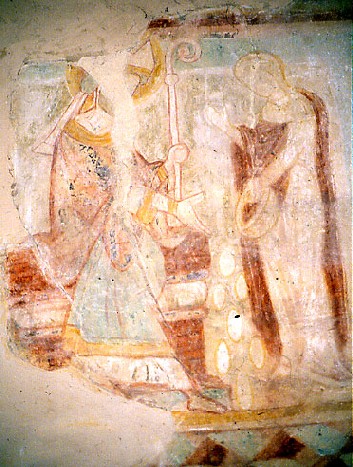Corhampton, Hampshire (†Portsmouth) C.13
Scenes from the Life of St Swithun

These paintings are on the south side of the chancel at Corhampton. At the right is a rearing horse with, faintly discernible, a rider on its back. In fact this horse may not be connected to the story that follows, although it is hard to account for otherwise.
Moving left, the horse is followed by a figure of a woman, faint, but visible except for her head. In her right hand, very difficult to see, she holds a basket which once contained eggs, shown now, again very faintly, as falling to the ground. Further left, the woman encounters two men, holding between them a pole of some kind from which something bag-like is suspended. From their general appearance, particularly the grim and determined face of the man furthest left, these two have deliberately sabotaged the woman’s basket.

The incident is recorded in the Golden Legend as taking place near the gate of the town of Winchester. After the disaster with her eggs, the woman enountered St Swithun, the bishop of Winchester, who restored them to her, and this is shown in the much clearer photograph at the right. On the left is Swithun, in full bishop’s regalia with mitre and pastoral staff. He extends his right hand toward the woman and her basket, into which the fallen eggs, now much clearer, rise, whole and complete. The woman raises her right hand in wonder at this remarkable sight.
The Corhampton painter has evidently decided to include a second man in the story along with the single ‘reckless fellow’ described in the Golden Legend. The incident is said to have taken place on a bridge built by Swithun himself, and the horizontal rectangular shape visible behind him may represent the parapet of this. The Golden Legend account insists that Swithun, a very unassuming bishop, went at all times ‘afoot’, rather than mounted on ‘gay horses’, which is why the rearing horse at the beginning of the sequence here is problematic.
But it is a very fine painting nonetheless, with crisply articulated outlines and graceful figures. As well as the usual reds and yellows, green and blue colouring has been used, particularly on Swithun’s robe. The painting has been restored, but very sensitively, and its position in a place of honour close to the altar on the south wall of the chancel is an indication of the esteem in which the medieval population of Corhampton held their painting and their former miracle-working bishop.
There are other paintings at Corhampton – a probable Appearance to Mary Magdalene, and some very good decorative work, including illusionistic swagged drapery and symbolic birds of prey resembling vultures.